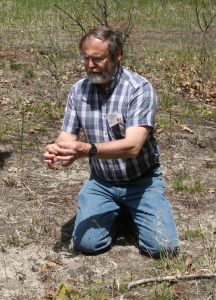Presented By: University of Michigan Biological Station
Looking For Tomorrow Through Yesterday: What Michigan’s Flora In 1840 Can Tell Us About Our Botanical Future
Dr. Anton Reznicek

Dr. Anton Reznicek (Curator of Vascular Plants at the U-M LSA Herbarium) will deliver the annual UMBS Bennett Endowed Lecture in Plant & Fungal Ecology.
It has become routine to predict the future of our biota by starting with present day distributions and broad-brush niches derived from these occurrences. Looking to the past and basing predictions on what has actually happened would seem to be very helpful in understanding the nature of the changes and refining approaches to studying change, but for plants we are typically hampered by lack of past floristic data. This is usually because we have little or no detailed information for floras before large scale European alteration of the landscape. Michigan, however, is unique in that immediately after becoming a State, in 1837, the State legislature, advised by forward thinking scientists, established the First Geological Survey of Michigan. The core idea was to produce detailed information on Michigan’s natural resources to provide a scientific foundation for the development of the State. Because at this time essentially all medicine was plant based, a detailed inventory of the Flora, supported by herbarium specimens, was a major thrust of the First Survey. Collating and studying this material laid the groundwork for understanding of our past flora in unusual depth. Three segments of this knowledge will be the primary focus. First, a review of the First Survey’s collecting activities (and those of a few other early collectors) and what we thus know about Michigan’s Flora in 1840. Second, a review of changes that have occurred that bring us, 180 years later, to the composition of our present day flora. In terms of species loss, this has been driven mostly by direct physical alteration of habitats, either complete elimination or drastic alteration of the hydrology and microhabitat conditions, especially in southern Michigan. Finally, knowing the operation of the past drivers of change, what can we infer about the changes we can expect in the
future?
It has become routine to predict the future of our biota by starting with present day distributions and broad-brush niches derived from these occurrences. Looking to the past and basing predictions on what has actually happened would seem to be very helpful in understanding the nature of the changes and refining approaches to studying change, but for plants we are typically hampered by lack of past floristic data. This is usually because we have little or no detailed information for floras before large scale European alteration of the landscape. Michigan, however, is unique in that immediately after becoming a State, in 1837, the State legislature, advised by forward thinking scientists, established the First Geological Survey of Michigan. The core idea was to produce detailed information on Michigan’s natural resources to provide a scientific foundation for the development of the State. Because at this time essentially all medicine was plant based, a detailed inventory of the Flora, supported by herbarium specimens, was a major thrust of the First Survey. Collating and studying this material laid the groundwork for understanding of our past flora in unusual depth. Three segments of this knowledge will be the primary focus. First, a review of the First Survey’s collecting activities (and those of a few other early collectors) and what we thus know about Michigan’s Flora in 1840. Second, a review of changes that have occurred that bring us, 180 years later, to the composition of our present day flora. In terms of species loss, this has been driven mostly by direct physical alteration of habitats, either complete elimination or drastic alteration of the hydrology and microhabitat conditions, especially in southern Michigan. Finally, knowing the operation of the past drivers of change, what can we infer about the changes we can expect in the
future?